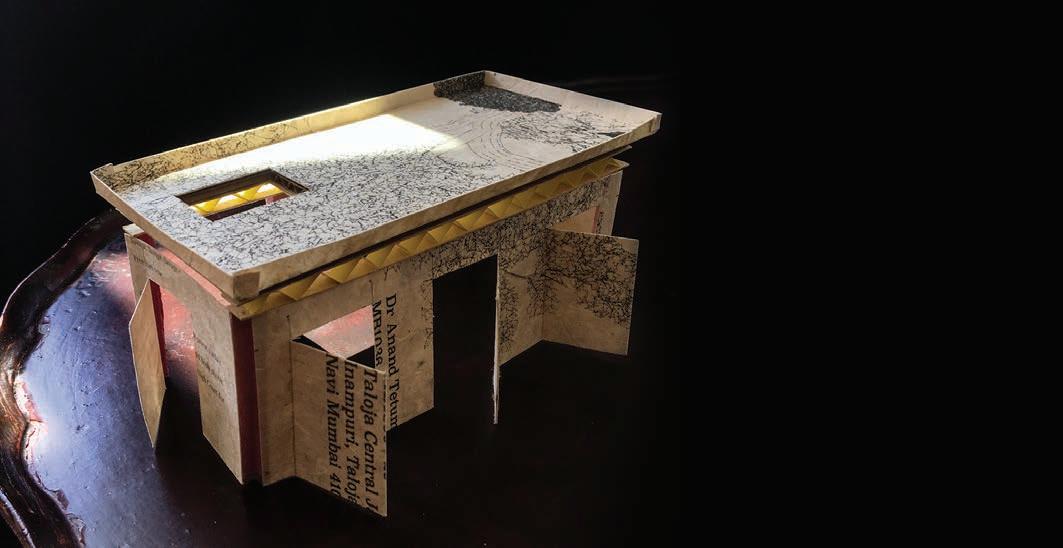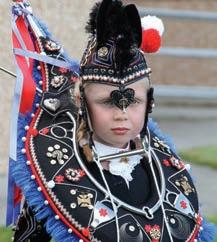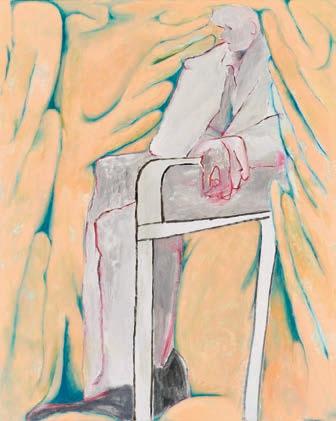
6 minute read
SPELLBINDING!
Sir Matthew Bourne talks about his version of Sleeping Beauty, visiting the Midlands this month as part of its ongoing 10th anniversary tour...
A firm favourite in the New Adventures company repertoire, Sir Matthew Bourne’s Sleeping Beauty continues to delight audiences with its sumptuous sets, stunning costumes and wonderful storytelling. What’s On recently caught up with the award-winning choreographer, who here provides a personal insight into his most spellbinding production.
Advertisement
Sleeping Beauty is interesting because I felt I had to find an original way of approaching this piece. I love the music, but it did feel very grand and very famous and very difficult to approach in many ways.
So I read everything around Sleeping Beauty - the fairytale versions, there a several, and various books about fairytales that give insight into the story. I watched lots of versions of the ballet. The thing that’s interesting about the story is that it covers a long period of time with the 100-year sleep of Aurora. But it was really the time period that influenced me the most. The ballet was created in 1890, so I said, ‘Why don’t we set the piece to begin in 1890?’ Then we go forwards in time to Aurora’s 21st birthday, which is in 1911. So then, with the 100-year curse [added], we are brought up to the present day. Unfortunately, that was 12 years ago! So now we’re sort of 112 years later, but we get around it by being a little vague about the time period when she wakes up!
What’s great about recreating a classical ballet is that you’ve got this incredible score which was all written to dance to. The music becomes your script and tells you what the feeling and the emotion of each scene should be.
We use the same piece of music at the beginning of act one and act two, to represent the baby Aurora and then the grown-up Aurora. The baby is very naughty, a real handful, and so is more-grown-up Aurora in a way; she’s a real wild child. By using the same piece of music, I thought that would tie them together. It’s different than in the ballet, but it sounds absolutely right.
Lez Brotherston, who is the designer I’ve worked with on most of the shows that we do, does similarly detailed research to me. He likes the sense of history in pieces, so this piece really appealed to him, resulting in an enormous number of costumes and wigs! It’s not only the reality of those time periods, but also fantasy, with fairies and wings and characters that are flights of fancy. Lez came up with amazing costumes for the fairies, all designed around different bird feathers. It gives him a chance to really be inventive and creative with those costumes, and they’re not referencing anything historical...
Something I’ve also noticed with Lez’s design is that he loves to be true to history. It’s a wonderful thing because it makes you understand why people held themselves in a certain way - because of a corset, or whatever it might be - and how that affects movement. When we originally developed the piece, we decided to set up the love story of Aurora and Leo. Leo is an invented character of ours and is her first love. He works in the gardens of the royal estate. When Aurora is cursed by Carabosse to sleep for 100 years, I realised that the question is, how can they be together in 100 years’ time? By turning the Lilac fairy, who is called Count Lilac in our version, into a vampire, he is able to give Leo the gift of eternal life. For me, that was a very romantic idea and perfect for this story because it allows Leo to be there when she wakes up. Of course there are consequences, as he’s now a vampire, but we sort of play with the idea that you can have a good vampire or a bad vampire, and that this story is very much about good versus evil.
Whenever I saw the classical ballet, there was always sort of a baby in the cot. She is the main character in the piece - Aurora - so I thought it would be great if we could give her a personality. One of the interesting ideas that Lez and I came up with early on was to use puppets. Could we represent Aurora with a puppet? I love to inject a bit of humour into the early part of a show so that people relax. They may be coming to a dance work for the first time, or thinking that they’re not going to get the story - but then if they laugh, they’re happy. In order to achieve the effect we want, several dancers are covered in black bodysuits, manipulating puppet Aurora, bringing her to life, and through the lighting you can’t even see that they’re there. It’s incredible, really.
It’s wonderful to see the different generations of dancers pass on their knowledge of the show. That’s why I also like a mix in a castpeople who’ve done a show before and new people who bring a fresh light to it. Unlike other companies, we get our dancers to work together on a role. They will share their experience of it, and the new person will bring some new ideas that will go into the role as well. So it becomes very rich because of the input of lots and lots of people.
The story is about the power of love; it’s about love across time that’s indestructible. That’s why I call it a gothic romance... the overriding emotion is love, and how two people [manage to] be together despite everything.
Matthew Bourne’s Sleeping Beauty shows at Birmingham Hippodrome from Tues 7 to Sat 11 February
Visual Arts previews from around the region
Divided Selves: Legacies, Memories, Belonging
Herbert Art Gallery & Museum, Coventry, Sat 18 February - Sun 24 September

Ideas of community and collective identity come under consideration in the Herbert’s first exhibition of the year.
Subtitled Legacies, Memories, Belongingand presented across four galleriesDivided Selves explores the process by which war and geo-politics have divided the world into nation states. The show also contemplates the concept of nation through shared stories, histories and cultural narratives, and considers the idea of collective identity via a selection of large-scale, immersive works.
The exhibition includes pieces from the Herbert’s Peace And Reconciliation collection, loans from the British Council Collection, and new commissions and works borrowed directly from the participating artists and their galleries.

Grayson’s Art Club
Midlands Arts Centre (MAC), Birmingham, until Sun 16 April
This critically acclaimed major exhibition comprises more than 100 artworks selected by Turner Prize winner Grayson Perry, his wife Philippa, and guest celebrities during season three of the popular TV series, Grayson’s Art Club. Using art as a way of ‘bringing together the nation’ by encouraging people to celebrate their collective creativity, the Channel Four show features work submitted by the public in a wide variety of mediums, including photography, painting, textiles and sculpture.
“The great thing about the Art Club exhibition,” says Grayson, “is that everybody who comes will find something they like because it’s so varied. And then they will identify with it and go: ‘Ooh, I think I could have a go at that.’
“That’s what I think the joy of Art Club is; that people can see themselves in the different characters, and then they might have found their creative outlet.”
Horror In The Modernist Block
Ikon Gallery, Birmingham, until Mon 1 May High-rise towers. Concrete buildings. In an exhibition featuring the work of 20 contemporary artists, these modernist structures are viewed through the lens of the horror genre with which they are often associated in dystopian fiction.
Using as its starting point Birmingham - a city renowned for its brutalist architecture - the show also contemplates the architecture of Ikon’s galleries, taking viewers on a journey that highlights how the design and features of a building can shape not only people’s movement and perception, but also their deepest fears.
Katrina Palmer: What’s Already Going On
Mead Gallery, Warwick Arts Centre, Coventry, until Sun 12 March
“Part of what’s always driven me is the edges of things,” explains Katrina Palmer. “I did a lot of work where I was often defining holes and voids and spaces, and making people walk around the edges of near boundaries and things like that. Rather than focusing on objects directly, I was looking at standing to the side of spaces.
“That’s what I’ve carried on doing in this show. There’ll be a corridor that takes you around the edges of the space, and any objects are kept at a distance, so you have to peer through walls to see them.”
Making Mischief: Folk Costume In Britain

Compton Verney, Warwickshire, Sat 11 February - Sun 11 June
The UK’s rich tapestry of local and seasonal folk customs - and in particular the central role played in these customs by the wearing of costumes - is the subject of this brand-new exhibition.
Not only celebrating grassroots traditions but also challenging the preconception that folk customs are fixed and nostalgic, Making Mischief brings together more than 40 costumes and highlights a number of evolving practices, such as the rise of all-female Morris groups.
Loans from the Museum of British Folklore, the English Folk Dance & Song Society and the English Folk Costume Archive are featured alongside works from Compton Verney’s own collection.
Pop Parade
Wolverhampton Art Gallery, until Sun 31 December
Showing throughout the year, Pop Parade is a celebration of Wolverhampton Art Gallery’s impressive collection of Pop Art - the largest in the UK outside of London.
The gallery began collecting in the late 1960s, at a time when the art form - which took its inspiration from popular culture - was still new and controversial.
The show features work by artists including Andy Warhol, Peter Blake, Pauline Boty, Eduardo Paolozzi and David Hockney.












